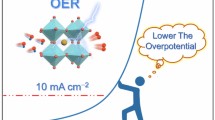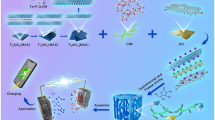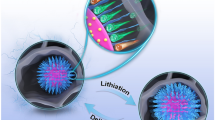Abstract
Developing high activity, low-cost and long durability catalysts for oxygen reduction reaction is of great significance for the practical application of microbial fuel cells. The full exposure of active sites in catalysts can enhance catalytic activity dramatically. Here, novel Fe-N-doped graphene is successfully synthesized via a one-step in situ ball milling method. Pristine graphite, ball milling graphene, N-doped graphene and Fe-N-doped graphene are applied in air cathodes, and enhanced performance is observed in microbial fuel cells with graphene-based catalysts. Particularly, Fe-N-doped graphene achieves the highest oxygen reduction reaction activity, with a maximum power density of 1380±20 mW/m2 in microbial fuel cells and a current density of 23.8 A/m2 at −0.16 V in electrochemical tests, which are comparable to commercial Pt and 390% and 640% of those of pristine graphite. An investigation of the material characteristics reveals that the superior performance of Fe-N-doped graphene results from the full exposure of Fe2O3 nanoparticles, pyrrolic N, pyridinic N and excellent Fe-N-G active sites on the graphene matrix. This work not only suggests the strategy of maximally exposing active sites to optimize the potential of catalysts but also provides promising catalysts for the use of microbial fuel cells in sustainable energy generation.

Similar content being viewed by others
Change history
06 July 2020
The authors wish to make some corrections as below:
References
Jain A, He Z (2018). “NEW” resource recovery from wastewater using bioelectrochemical systems: Moving forward with functions. Frontiers of Environmental Science & Engineering, 12(4): 3–15
Bashyam R, Zelenay P (2006). A class of non-precious metal composite catalysts for fuel cells. Nature, 443(7107): 63–66
Cao C, Wei L, Wang G, Shen J (2017a). Superiority of boron, nitrogen and iron ternary doped carbonized graphene oxide-based catalysts for oxygen reduction in microbial fuel cells. Nanoscale, 9(10): 3537–3546
Cao C, Wei L, Zhai Q, Ci J, Li W, Wang G, Shen J (2017b). Gas-flow tailoring fabrication of graphene-like Co-Nx-C nanosheet supported sub-10 nm PtCo nanoalloys as synergistic catalyst for air-cathode microbial fuel cells. ACS Applied Materials & Interfaces, 9(27): 22465–22475
Chen X, Li F, Zhang N, An L, Xia D (2013). Mechanism of oxygen reduction reaction catalyzed by Fe(Co)-Nx/C. Physical chemistry chemical physics, 15(44): 19330–19336
Chen Z, Higgins D, Yu A, Zhang L, Zhang J (2011). A review on non-precious metal electrocatalysts for PEM fuel cells. Energy & Environmental Science, 4(9): 3167–3192
Chen Z Y, Li Y N, Lei L L, Bao S J, Wang M Q, Liu H, Zhao Z L, Xu M (2017). Investigation of Fe2N@Carbon encapsulated in N-doped graphene-like carbon as a catalyst in sustainable zinc-air batteries. Catalysis Science & Technology, 7(23): 5670–5676
Choi C H, Choi W S, Kasian O, Mechler A K, Sougrati M T, Brüller S, Strickland K, Jia Q, Mukerjee S, Mayrhofer K J J, Jaouen F (2017). Unraveling the nature of sites active toward hydrogen peroxide reduction in Fe-N-C catalysts. Angewandte Chemie International Edition, 56(30): 8809–8812
Chuong N D, Thanh T D, Kim N H, Lee J H (2018). Hierarchical heterostructures of ultrasmall Fe2O3-encapsulated MoS2/N-graphene as an effective catalyst for oxygen reduction reaction. ACS Applied Materials & Interfaces, 10(29): 24523–24532
Durán F G, Barbero B P, Cadús L E, Rojas C, Centeno M A, Odriozola J A (2009). Manganese and iron oxides as combustion catalysts of volatile organic compounds. Applied Catalysis B: Environmental, 92(1–2): 194–201
Ferrari A C, Meyer J C, Scardaci V, Casiraghi C, Lazzeri M, Mauri F, Piscanec S, Jiang D, Novoselov K S, Roth S, Geim A K (2006). Raman spectrum of graphene and graphene layers. Physical Review Letters, 97(18): 187401(1)–187401(4)
Guo D, Shibuya R, Akiba C, Saji S, Kondo T, Nakamura J (2016). Active sites of nitrogen-doped carbon materials for oxygen reduction reaction clarified using model catalysts. Science, 351(6271): 361–365
Guo X, Jia J, Dong H, Wang Q, Xu T, Fu B, Ran R, Liang P, Huang X, Zhang X (2019a). Hydrothermal synthesis of Fe-Mn bimetallic nanocatalysts as high-efficiency cathode catalysts for microbial fuel cells. Journal of Power Sources, 414: 444–452
He D, Xiong Y, Yang J, Chen X, Deng Z, Pan M, Li Y, Mu S (2017). Nanocarbon-intercalated and Fe-N-codoped graphene as a highly active noble-metal-free bifunctional electrocatalyst for oxygen reduction and evolution. Journal of Materials Chemistry. A, Materials for Energy and Sustainability, 5(5): 1930–1934
Hossen M M, Artyushkova K, Atanassov P, Serov A (2018). Synthesis and characterization of high performing Fe-N-C catalyst for oxygen reduction reaction (ORR) in Alkaline Exchange Membrane Fuel Cells. Journal of Power Sources, 375: 214–221
Huang K, Zhang L, Xu T, Wei H, Zhang R, Zhang X, Ge B, Lei M, Ma J-Y, Liu L-M, Wu H (2019). 60 °C solution synthesis of atomically dispersed cobalt electrocatalyst with superior performance. Nature Communications, 10(1): 606(601–610)
Jiang C, Liu L, Crittenden J C. (2016). An electrochemical process that uses an Fe0/TiO2 cathode to degrade typical dyes and antibiotics and a bio-anode that produces electricity. Frontiers of Environmental Science & Engineering, 10(4): 25–32
Jiang Z J, Jiang Z, Chen W (2014). The role of holes in improving the performance of nitrogen-doped holey graphene as an active electrode material for supercapacitor and oxygen reduction reaction. Journal of Power Sources, 251: 55–65
Lai L, Potts J R, Zhan D, Wang L, Poh C K, Tang C, Gong H, Shen Z, Lin J, Ruoff R S (2012). Exploration of the active center structure of nitrogen-doped graphene-based catalysts for oxygen reduction reaction. Energy & Environmental Science, 5(7): 7936–7942
Li Q, Chen W, Xiao H, Gong Y, Li Z, Zheng L, Zheng X, Yan W, Cheong W C, Shen R, Fu N, Gu L, Zhuang Z, Chen C, Wang D, Peng Q, Li J, Li Y (2018). Fe isolated single atoms on S, N codoped carbon by copolymer pyrolysis strategy for highly efficient oxygen reduction reaction. Advanced materials, 30(25): 1800588
Liang W, Chen J, Liu Y, Chen S (2014). Density-functional-theory calculation analysis of active sites for four-electron reduction of O2 on Fe/N-doped graphene. ACS Catalysis, 4(11): 4170–4177
Lin T, Tang Y, Wang Y, Bi H, Liu Z, Huang F, Xie X, Jiang M (2013). Scotch-tape-like exfoliation of graphite assisted with elemental sulfur and graphene-sulfur composites for high-performance lithium-sulfur batteries. Energy & Environmental Science, 6(4): 1283–1290
Liu Q, Zhou Y, Chen S, Wang Z, Hou H, Zhao F (2015). Cellulose-derived nitrogen and phosphorus dual-doped carbon as high performance oxygen reduction catalyst in microbial fuel cell. Journal of Power Sources, 273: 1189–1193
Liu X, Dai L (2016). Carbon-based metal-free catalysts. Nature Reviews Materials, 1(11): 16064(1–12)
Liu Y, Liu H, Wang C, Hou S X, Yang N (2013). Sustainable energy recovery in wastewater treatment by microbial fuel cells: Stable power generation with nitrogen-doped graphene cathode. Environmental Science & Technology, 47(23): 13889–13895
Liu Y, Zhao Y, Li K, Wang Z, Tian P, Liu D, Yang T, Wang J (2018). Activated carbon derived from chitosan as air cathode catalyst for high performance in microbial fuel cells. Journal of Power Sources, 378: 1–9
Lu X, Zeng Y, Yu M, Zhai T, Liang C, Xie S, Balogun M S, Tong Y (2014). Oxygen-deficient hematite nanorods as high-performance and novel negative electrodes for flexible asymmetric supercapacitors. Advanced materials, 26(19): 3148–3155
Malard L M, Pimenta M A, Dresselhaus G, Dresselhaus M S (2009). Raman spectroscopy in graphene. Physics Reports, 473(5–6): 51–87
Nadeem M, Yasin G, Bhatti M H, Mehmood M, Arif M, Dai L (2018). Pt-M bimetallic nanoparticles (M = Ni, Cu, Er) supported on metal organic framework-derived N-doped nanostructured carbon for hydrogen evolution and oxygen evolution reaction. Journal of Power Sources, 402: 34–42
Niu Y, Huang X, Hu W (2016). Fe3C nanoparticle decorated Fe/N doped graphene for efficient oxygen reduction reaction electrocatalysis. Journal of Power Sources, 332: 305–311
Oh W D, Lisak G, Webster R D, Liang Y N, Veksha A, Giannis A, Moo G S, Lim J W, Lim T T (2018). Insights into the thermolytic transformation of lignocellulosic biomass waste to redox-active carbocatalyst: Durability of surface active sites. Applied Catalysis B: Environmental, 233: 120–129
Qu L, Liu Y, Baek J B, Dai L (2010). Nitrogen-doped graphene as efficient metal-free electrocatalyst for oxygen reduction in fuel cells. ACS Nano, 4(3): 1321–1326
Ren G, Li Y, Guo Z, Xiao G, Zhu Y, Dai L, Jiang L (2015). A bio-inspired Co3O4-polypyrrole-graphene complex as an efficient oxygen reduction catalyst in one-step ball milling. Nano Research, 8(11): 3461–3471
Santoro C, Arbizzani C, Erable B, Ieropoulos I (2017). Microbial fuel cells: From fundamentals to applications: A review. Journal of Power Sources, 356: 225–244
Solomon E I, Stahl S S (2018). Introduction: Oxygen reduction and activation in catalysis. Chemical Reviews, 118(5): 2299–2301
Stacy J, Regmi Y N, Leonard B, Fan M (2017). The recent progress and future of oxygen reduction reaction catalysis: A review. Renewable & Sustainable Energy Reviews, 69: 401–414
Sun M, Zhai L F, Li W W, Yu H Q (2016). Harvest and utilization of chemical energy in wastes by microbial fuel cells. Chemical Society Reviews, 45(10): 2847–2870
Tang H, Cai S, Xie S, Wang Z, Tong Y, Pan M, Lu X (2016). Metal-organic-framework-derived dual metal- and nitrogen-doped carbon as efficient and robust oxygen reduction reaction catalysts for microbial fuel cells. Advanced science, 3(2): 1500265
Tian G, Zhang Q, Zhang B, Jin Y, Huang J, Su D S, Wei F (2014). Toward full exposure of “active sites”: Nanocarbon electrocatalyst with surface enriched nitrogen for superior oxygen reduction and evolution reactivity. Advanced Functional Materials, 24(38): 5956–5961
Wang Q, Lei Y, Chen Z, Wu N, Wang Y, Wang B, Wang Y (2018). Fe/Fe3C@C nanoparticles encapsulated in N-doped graphene-CNTs framework as an efficient bifunctional oxygen electrocatalyst for robust rechargeable Zn-air batteries. Journal of Materials Chemistry. A, Materials for Energy and Sustainability, 6(2): 516–526
Wang Q, Zhang X, Lv R, Chen X, Xue B, Liang P, Huang X (2016). Binder-free nitrogen-doped graphene catalyst air-cathodes for microbial fuel cells. Journal of Materials Chemistry. A, Materials for Energy and Sustainability, 4(32): 12387–12391
Xia X, Zhang F, Zhang X, Liang P, Huang X, Logan B E (2013). Use of pyrolyzed iron ethylenediaminetetraacetic acid modified activated carbon as air-cathode catalyst in microbial fuel cells. ACS Applied Materials & Interfaces, 5(16): 7862–7866
Xiao M, Zhu J, Ma L, Jin Z, Ge J, Deng X, Hou Y, He Q, Li J, Jia Q, Mukerjee S, Yang R, Jiang Z, Su D, Liu C, Xing W (2018). Microporous framework induced synthesis of single-atom dispersed Fe-N-C acidic ORR catalyst and its in situ reduced Fe-N4 active site identification revealed by X-ray absorption Spectroscopy. ACS Catalysis, 8(4): 2824–2832
Yang W, Li J, Ye D, Zhu X, Liao Q (2017). Bamboo charcoal as a cost-effective catalyst for an air-cathode of microbial fuel cells. Electrochimica Acta, 224: 585–592
Yin H, Zhang C, Liu F, Hou Y (2014). Doped graphene: Hybrid of iron nitride and nitrogen-doped graphene aerogel as synergistic catalyst for oxygen reduction reaction. Advanced Functional Materials, 24(20): 2930–2937
Yuan H, Hou Y, Aub-Reesh I M A, Chen J, He Z (2016). Oxygen reduction reaction catalysts used in microbial fuel cells for energy-efficient wastewater treatment: A review. Materials Horizons, 3(5): 382–401
Zhang B, Wen Z, Ci S, Mao S, Chen J, He Z (2014a). Synthesizing nitrogen-doped activated carbon and probing its active sites for oxygen reduction reaction in microbial fuel cells. ACS Applied Materials & Interfaces, 6(10): 7464–7470
Zhang L, Ni Y, Wang X, Zhao G (2010). Direct electrocatalytic oxidation of nitric oxide and reduction of hydrogen peroxide based on-Fe2O3 nanoparticles-chitosan composite. Talanta, 82(1): 196–201
Zhang X, Pant D, Zhang F, Liu J, He W, Logan B E (2014b). Long-term performance of chemically and physically modified activated carbons in air cathodes of microbial fuel cells. ChemElectroChem, 1(11): 1859–1866
Zhang X, Xia X, Ivanov I, Huang X, Logan B E (2014c). Enhanced activated carbon cathode performance for microbial fuel cell by blending carbon black. Environmental Science & Technology, 48(3): 2075–2081
Zhao Q, Yu H, Zhang W, Kabutey F T, Jiang J, Zhang Y, Wang K, Ding J (2017). Microbial fuel cell with high content solid wastes as substrates: A review. Frontiers of Environmental Science & Engineering, 11(2): 25–41
Wu Z Y, Xu X X, Hu B C, Liang H W, Lin Y, Chen L F, Yu S H (2015). Iron carbide nanoparticles encapsulated in mesoporous Fe-N-doped carbon nanofibers for efficient electrocatalysis. Angewandte Chemie (International ed. in English), 54(28): 8179–8183
Zhuang S, Lee E S, Lei L, Nunna B B, Kuang L, Zhang W (2016). Synthesis of nitrogen-doped graphene catalyst by high-energy wet ball milling for electrochemical systems. International Journal of Energy Research, 40(15): 2136–2149
Zhuang S, Nunna B B, Lee E S (2018). Metal organic framework-modified nitrogen-doped graphene oxygen reduction reaction catalyst synthesized by nanoscale high-energy wet ball-milling structural and electrochemical characterization. MRS Communications, 8(01): 40–48
Zitolo A, Goellner V, Armel V, Sougrati M T, Mineva T, Stievano L, Fonda E, Jaouen F (2015). Identification of catalytic sites for oxygen reduction in iron- and nitrogen-doped graphene materials. Nature Materials, 14(9): 937–942
Acknowledgements
This research was supported by the National Natural Science Foundation of China (Grant No. 51778326) and the special fund of Tsinghua University Initiative Scientific Research Program. We thank Prof. Rufan Zhang at Tsinghua University for valuable comments and suggestions.
Author information
Authors and Affiliations
Corresponding author
Additional information
Highlights
•Nano Fe2O3 and N-doped graphene was prepared via a one-step ball milling method.
•The maximum power density of Fe-N-G in MFC was 390% of that of pristine graphite.
•Active sites like nano Fe2O3, pyridinic N and Fe-N groups were formed in Fe-N-G.
•The improvement of Fe-N-G was due to full exposure of active sites on graphene.
Electronic supplementary material
Rights and permissions
About this article
Cite this article
Guo, X., Wang, Q., Xu, T. et al. One-step ball milling-prepared nano Fe2O3 and nitrogen-doped graphene with high oxygen reduction activity and its application in microbial fuel cells. Front. Environ. Sci. Eng. 14, 30 (2020). https://doi.org/10.1007/s11783-019-1209-1
Received:
Revised:
Accepted:
Published:
DOI: https://doi.org/10.1007/s11783-019-1209-1




